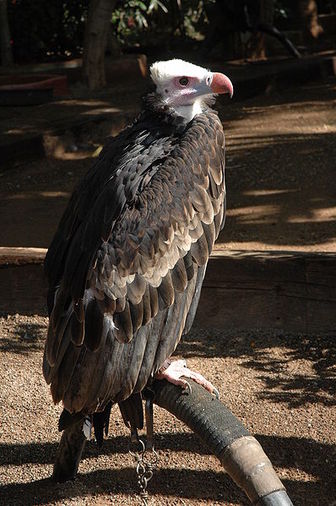White-headed Vulture
This is a medium-sized vulture, 72–85 cm in length and 207–230 cm in wingspan. Females weigh more than males; they usually weigh around 4.7 kg , while males weigh 4 kg or less.

Original source: flickrUploaded by Snowmanradio
Author: stephen jones from uk
The White-headed Vulture is classified as Vulnerable (VU), considered to be facing a high risk of extinction in the wild.
The White-headed Vulture (Trigonoceps occipitalis) is an Old World vulture endemic to Africa. It has a pink beak and a white crest, and the featherless areas on its head are pale. Its has dark brown upper parts and black tail feathers. The feathers on its lower parts and legs are white. It has a wing span of 2 m and spends a lot of time soaring looking for food. It roosts in tall trees near to water at night. More
This White-headed Vulture, trigonoceps occipitalis, is also photographed in the bird park in a very big aviary. It is there together with a lot of other vultures because of illegal trade. The Italian customs-officers had caught a smuggling gang. But they dont know where to go with these birds. They couldnt replace the birds in the wild. So, this bird park has taken a pity up these animals. So thats why they are here. More
White-Headed Vultures (Photograph Courtesy of Africam Copyright More
white-headed vulture gets its name from the downy, white feathers on its head which give it an angular appearance. The bright facial colours contrast sharply with the black body, tail, wings and high ruff around its neck. The belly and thighs are white and its legs are pale pink (2) (4). Like other vultures, the white-headed vulture has a number of adaptations for feeding on the carcasses of large animals, but is also capable of killing small prey. More
The white-headed vulture (Trigonoceps occipitalis) is about 80 cm (31 inches) long and has a wingspan of about 1.8 metres (6 feet). Black with white secondary wing feathers and belly, it has a high black neck fringe and a massive red beak. This bird has a uniquely triangular head, which is pale yellowish and bare except for a cap of... More
Though the white-headed vulture feeds frequently on carrion, it is known to equally often hunt live prey to supplement its diet. This bird, with its strong talons unusual to members of the vulture family, is capable of tackling prey as large as flamingoes though it will also feed on small animals such as lizards. It is even rumored that this large bird will occasionally take a small antelope. More
The white-headed vulture is an early riser and flies out from its roost earlier in the day than other vultures (4). It is often the first vulture to arrive at a kill made by carnivores during the previous night, and will feed on carrion and bone fragments in peace for a while before other vultures arrive (2), whereupon the white-headed vulture generally retreats (4) (7). More
White-headed Vulture In Barnes KN (ed) The Eskom Red data book of birds of South Africa, Lesotho and Swaziland. Birdlife South Africa, Johannesburg. Barnes KN (ed) 2000.The Eskom Red data book of birds of South Africa, Lesotho and Swaziland. Birdlife South Africa, Johannesburg. Birdlife International 2004 Threatened Birds of the World. CD Birdlife International, Cambridge. Bridgeford P 2001 More vulture deaths in Namibia. Vulture News 44: 22-26. More
There was a White-headed Vulture standing on the outskirts which was another of our key species for the Mara trip. white-headed vulture in the mara White-headed Vulture We had to get back to Nairobi for a friend’s photo exhibition so we set off after four days in the Mara. Just as we got through the gate, we got a phone call saying that cheetahs had killed an impala but it was too late for us to go back. More
White-headed Vultures occur singly or in pairs and are often the first to arrive at a carcass. Like the Lappet-faced Vulture they are able to eat skin, ligament and bones however, unlike the Lappet-faced Vulture they are "clean" feeders (ie they do not get blood on their feathers when they feed). Although they get to a kill first they tend to feed on scraps dropped by, or stolen from, other raptors. They take these to one side, eating them away from the main huddle. More
Distribution of White-headed vulture in southern Africa, based on statistical smoothing of the records from first SA Bird Atlas Project (© Animal Demography unit, University of Cape Town; smoothing by Birgit Erni and Francesca Little). Colours range from dark blue (most common) through to yellow (least common). See here for the latest distribution from the SABAP2. Predators and parasites Nestlings have been recorded as prey of Aquila verreauxii (Verreauxs' eagle). More
The White-headed Vulture (Trigonoceps occipitalis) is an African species occurring in desert, open plains and grasslands from Senegal and Gambia south all the way to South Africa. The shots here were taken in Kruger National Park, Mpumalanga Province, South Africa, in January, 2006 with a Canon EOS 1D Mark II & EF 500mm F/4L IS lens and 1.4X extender. The top two shots show a bird preening at dawn. The third shot shows the same individual in the same tree at noon that same day. More

Original source: Michael Jefferies
-Michael Jefferies -Author: Michael Jefferies
Permission: Some rights reserved
Family : Accipitridae
Genus : Trigonoceps
Species : occipitalis
Authority : (Burchell, 1824)

